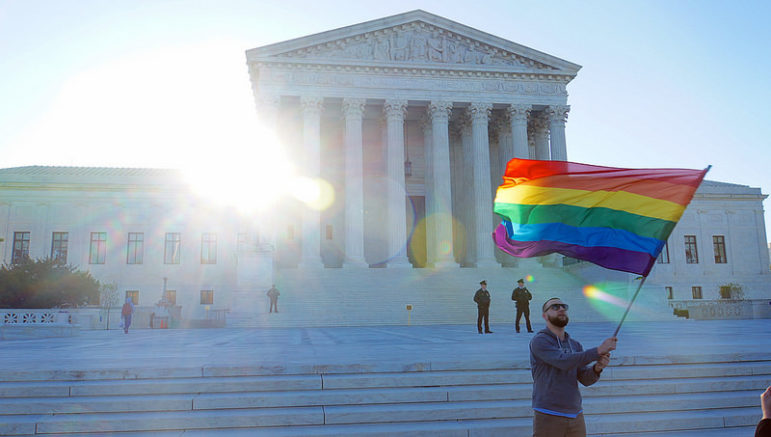
Editor’s note: As we celebrate the anniversary of the Obergefell v. Hodges ruling that affirmed that same-sex couples throughout the United States have the right to marry, we are pleased to print this “Voices from the Field,” published in its initial form in Washington Monthly. Nonprofit organizations and grassroots groups spent a decade bringing this cause to its ultimate fruition; this story comes from one such entity.
On June 26, 2015, history was made when the U.S. Supreme Court made marriage equality the law of the land. This victory for social justice would not have been achieved without the efforts of tenacious leaders and litigators, diverse LGBT organizations, straight allies, elected officials, celebrities, and most importantly, hundreds of thousands of people toiling at the grassroots level. But a crucial, and largely unknown, force was also at work: the Civil Marriage Collaborative, a consortium of foundations that helped change hearts and minds—and move the country toward marriage equality.
The Civil Marriage Collaborative (known as the CMC) was created in 2004, at a time when there was strong backlash against the idea of gay marriage. Less than a year earlier, the Massachusetts high court had ruled that the state’s ban on same-sex marriage was unconstitutional, a decision that prompted a media and political firestorm. President George W. Bush called for amending the U.S. Constitution to ban same-sex marriage, and similar measures started making their way to the ballots in more than a dozen states. The LGBT movement was overwhelmed: It did not have the financial or operational capacity to mount the larger public education, policy advocacy and litigation effort that was needed to deal with the onslaught.
A Vision to Win
That’s when a handful of foundations came together to create the CMC, which would work in tandem with Freedom to Marry, an organization founded in 2003 that would eventually become the engine of the marriage equality movement. Launched with a grant from the Evelyn and Walter Haas, Jr. Fund in San Francisco, and led by Evan Wolfson, Freedom to Marry was based on a simple premise: Civil unions and domestic partnerships did not go far enough in removing obstacles for gays and lesbians in virtually every area of mainstream life. And by securing marriage equality, the LGBT community would gain rights in many other areas, such as in health care and the right to adoption.
No individual foundation could achieve this goal by itself, which is why the collaborative spirit of the CMC was so vital, both financially and logistically. From 2004 to 2015, the CMC and its funders contributed together and separately $153 million to build and strengthen a broad and diverse grassroots constituency and powerful public education apparatus to advance the marriage equality movement. Just as important, the CMC and its funders played a critical role in helping the LGBT movement develop, coalesce around and pursue a shared strategy to secure the freedom to marry state by state and then nationwide. Indeed, the formation of the Civil Marriage Collaborative proved to be a classic example of how foundations could come together and effect social change on a massive scale, for relatively little money.
It was not an easy task. Along the way, the movement faced losses and other major setbacks—California’s anti-marriage measure Proposition 8, just to name one. By exploiting fear and ignorance about gay people, opponents had real success in claiming that marriage equality would damage the institution of marriage and harm kids. Much of the problem at the ballot box could be traced to a perceived values gap: Research showed that most Americans didn’t think gay people shared their values. Instead, they saw gays and lesbians as unconnected to family, church, and other societal institutions.
Sign up for our free newsletters
Subscribe to NPQ's newsletters to have our top stories delivered directly to your inbox.
By signing up, you agree to our privacy policy and terms of use, and to receive messages from NPQ and our partners.
The movement knew it wasn’t connecting with the public and began investing in deep psychographic research to determine what was really going on inside people’s heads. This more exhaustive research—which involved focus groups, multi-hour interviews with carefully selected individuals, and developing and testing dozens of different approaches—was quite expensive. The initial investment cost 10 times more than a typical statewide poll in California, not even factoring in the expenses of further research and testing. Finding the money was extraordinarily challenging.
Changing Hearts and Minds
Over time, we learned that our side was making a huge mistake leading with an “equal rights and benefits” argument, which is what superficial polling said was the best approach. Why was this a mistake? In hindsight, it seems painfully obvious: the research showed that when straight people were asked why they got married, they said for love and commitment. But when asked why gay people got married, the straight respondents said “for rights and benefits.” In other words, our “rights and benefits” frame only reinforced the belief that gay people were operating from an entirely different values frame—love vs. a better dental plan.
From that point on, the movement changed its message: Gay marriage was not about rights and responsibilities—it was about love. And we learned that the most effective messengers were not gay couples, but rather parents or grandparents of gay and lesbian people who had been married for decades. It was a strategy that resonated with everyone. The marriage movement had finally found to way to move hearts and minds on marriage.
The CMC and its partners kept moving forward, consistently aligning grant dollars behind the marriage movement’s shared strategic plan. That involved supporting a wide range of related activities, including national coordination through Freedom to Marry, litigation, public education, community organizing and robust communications. In key states, for example, foundation dollars supported public education campaigns that included door-to-door canvassing, polling, phone-banking, mobilizing faith communities and earned and paid media.
There were many ups and downs and it wasn’t a flashy approach, but it played a significant role in getting marriage equality across the finish line, dramatically increasing public support for marriage equality and relegating laws like “Don’t Ask, Don’t Tell” and the Defense of Marriage Act to the dustbin of history.
It’s not every day in a social justice movement when you can actually win and say that the job is done now, but in the case of marriage equality, that’s exactly what has happened. Both Freedom to Marry and the Civil Marriage Collaborative are triumphantly shutting their doors, a testament to what foundations can bring to the table, particularly when they work together. It also shows what can happen when we remain true to our values, when we connect our hopes and dreams to a broader vision for the nation, and when we take action to ensure that everyone has opportunities to thrive.









